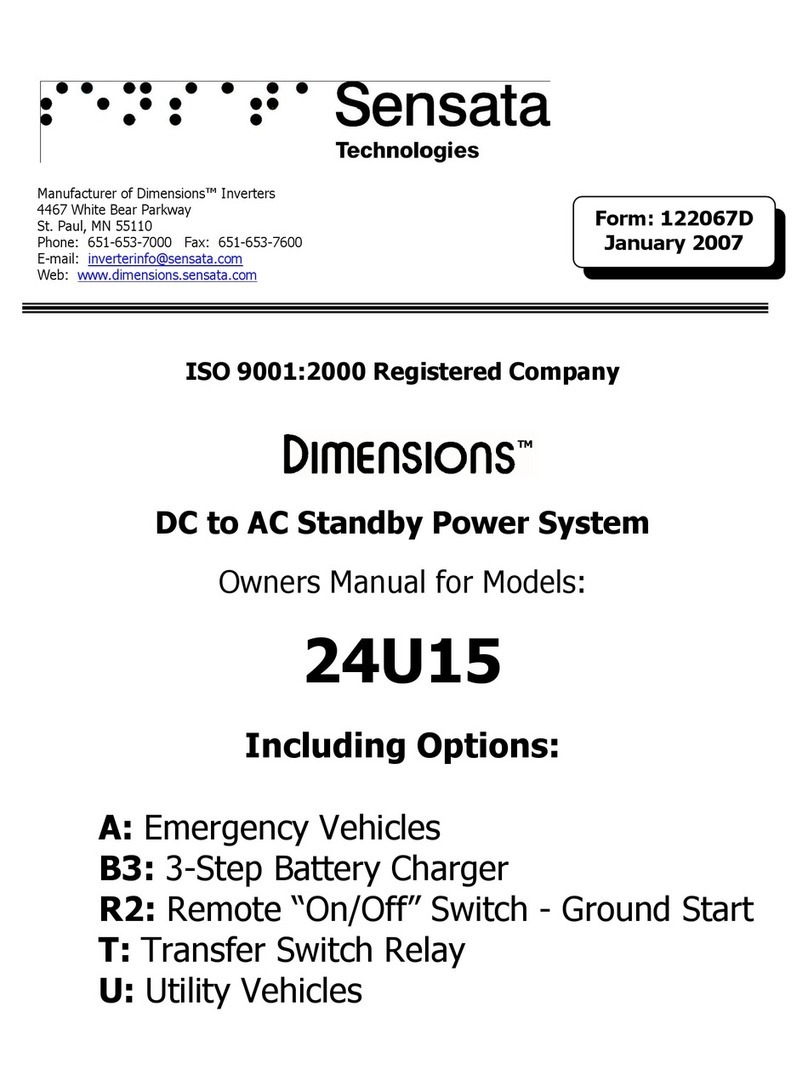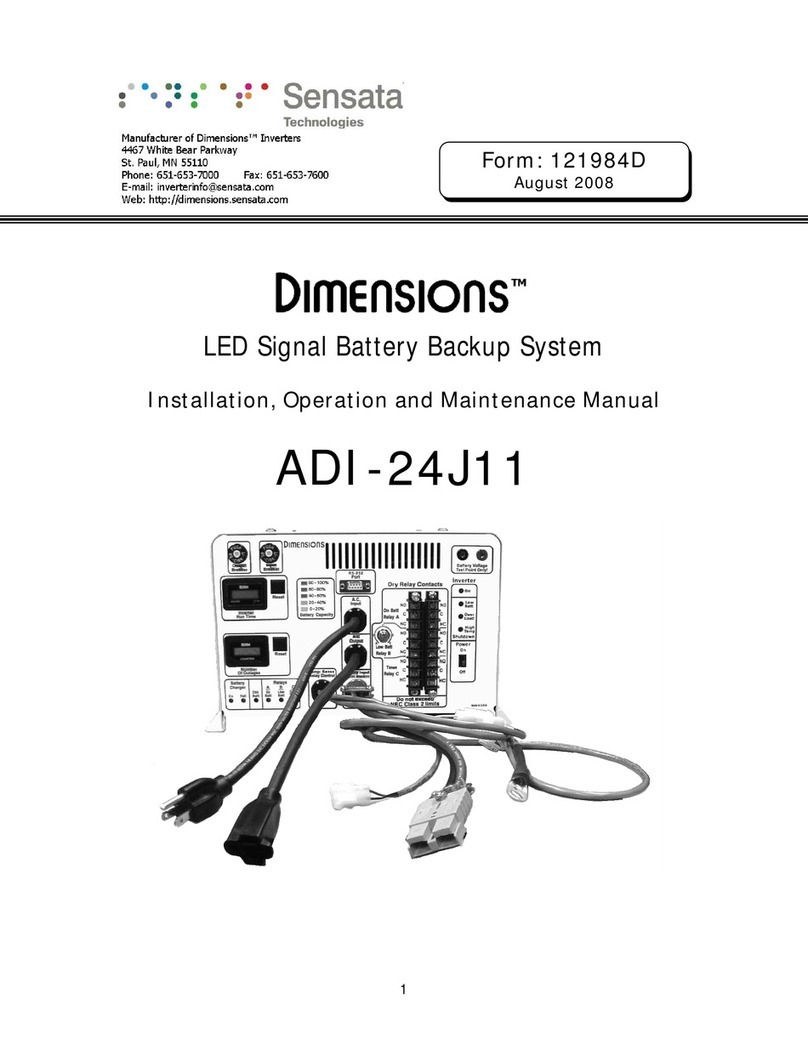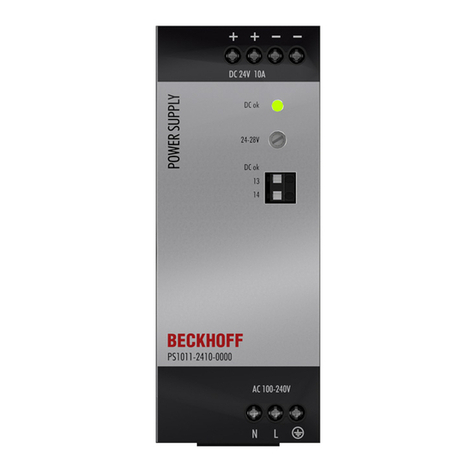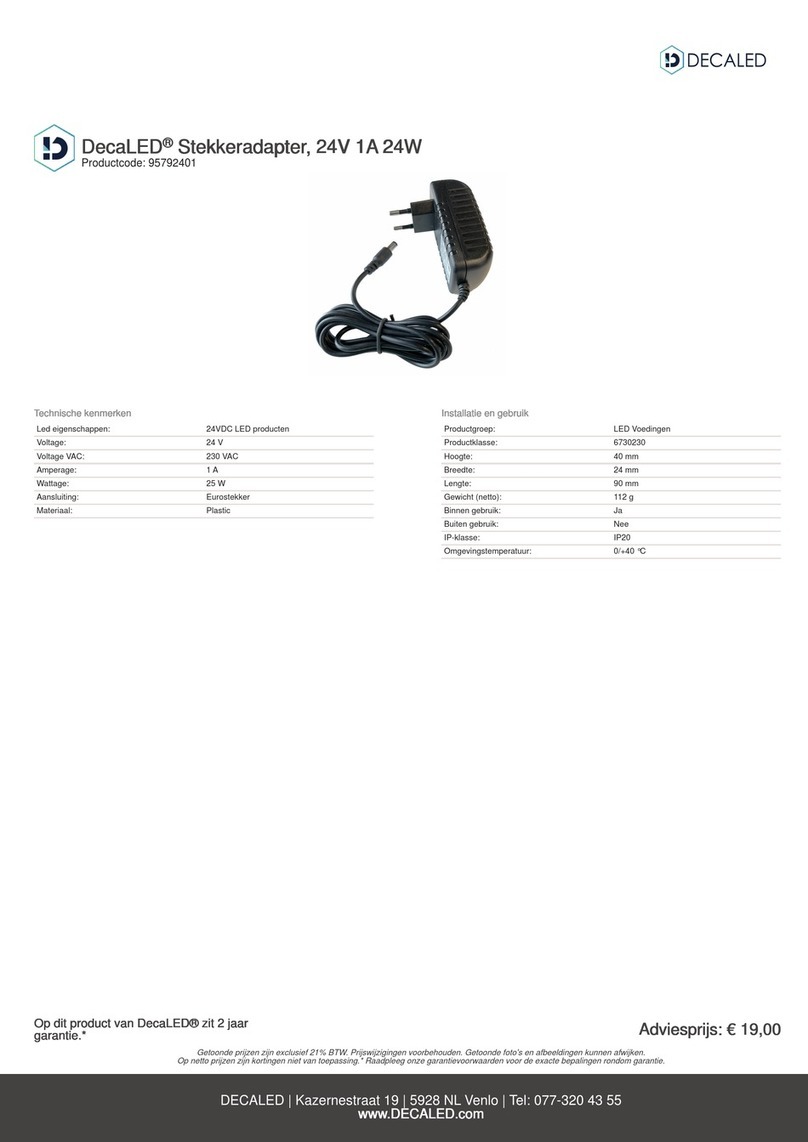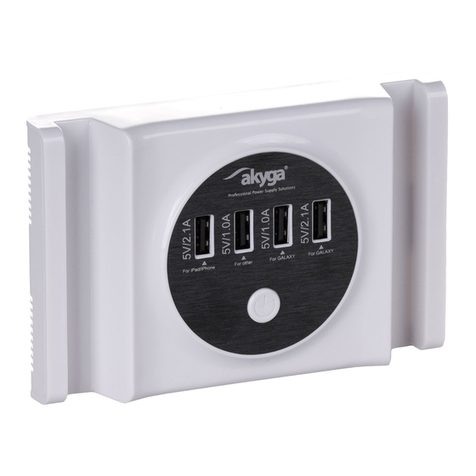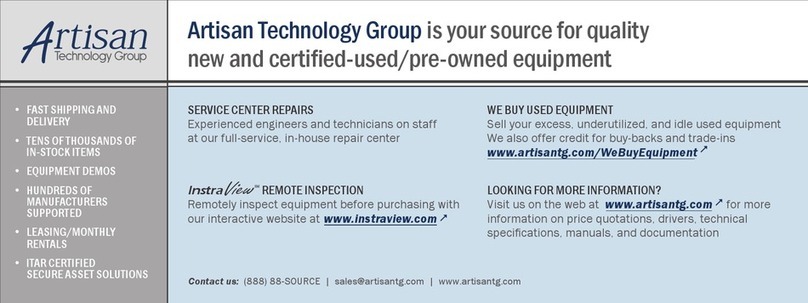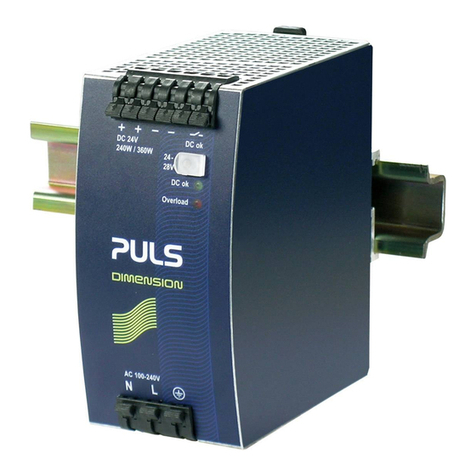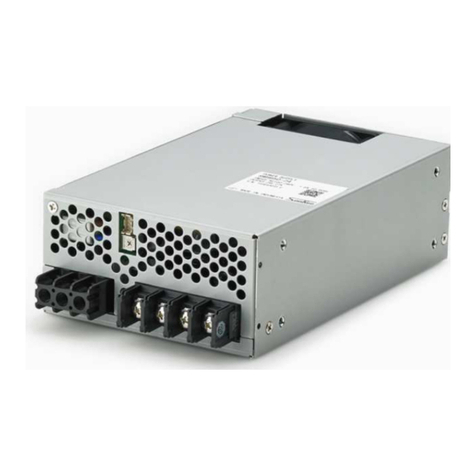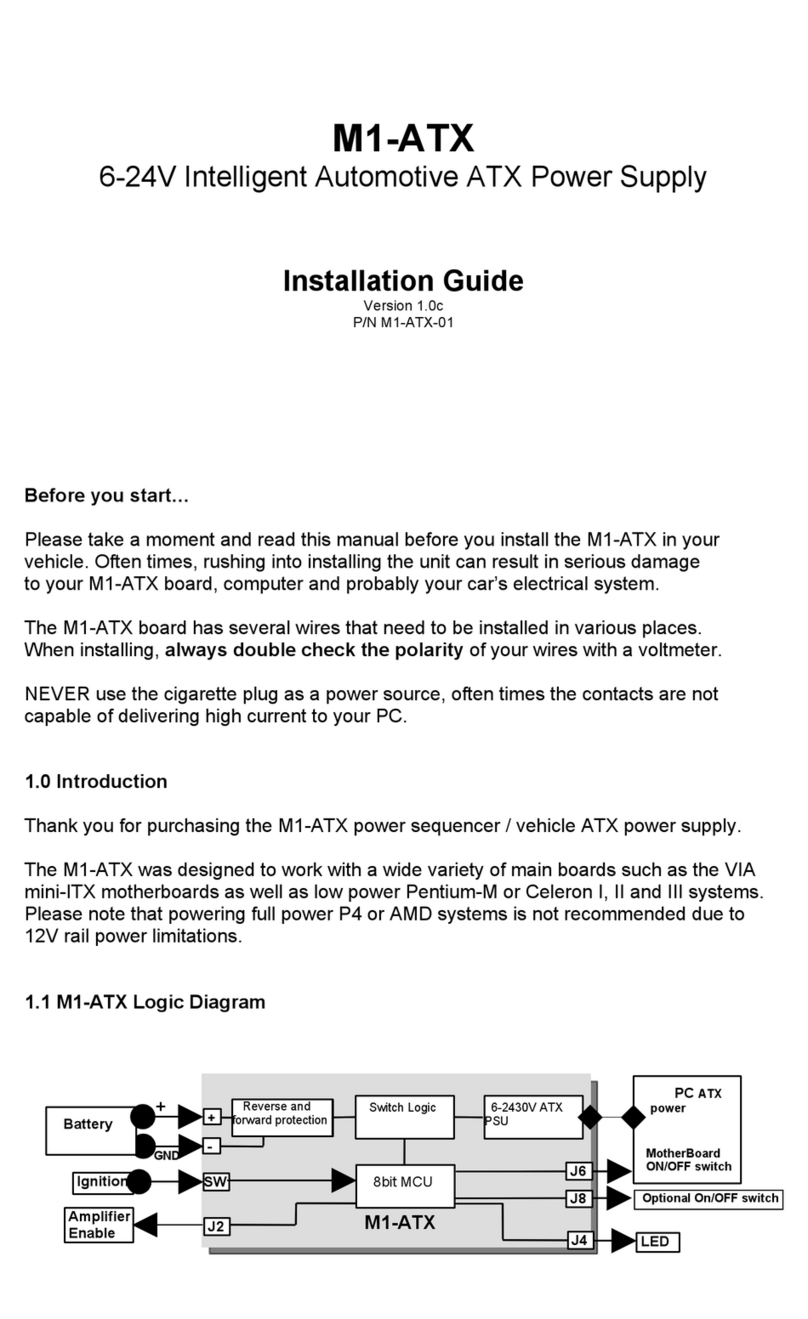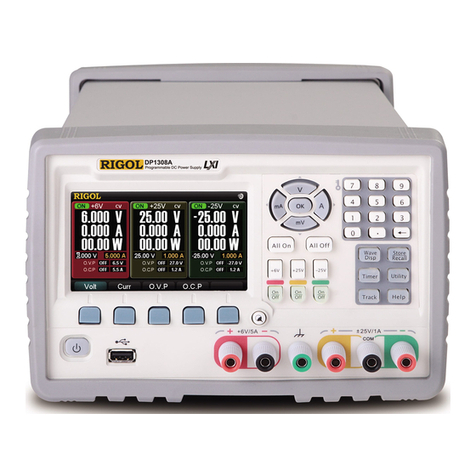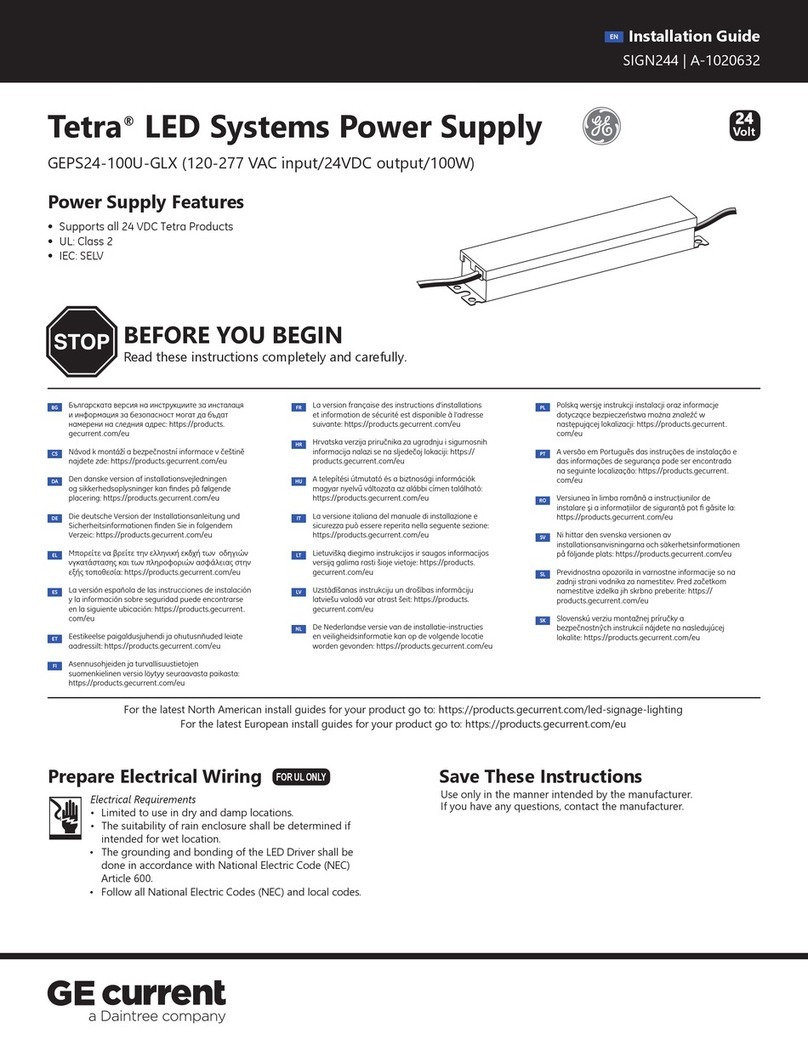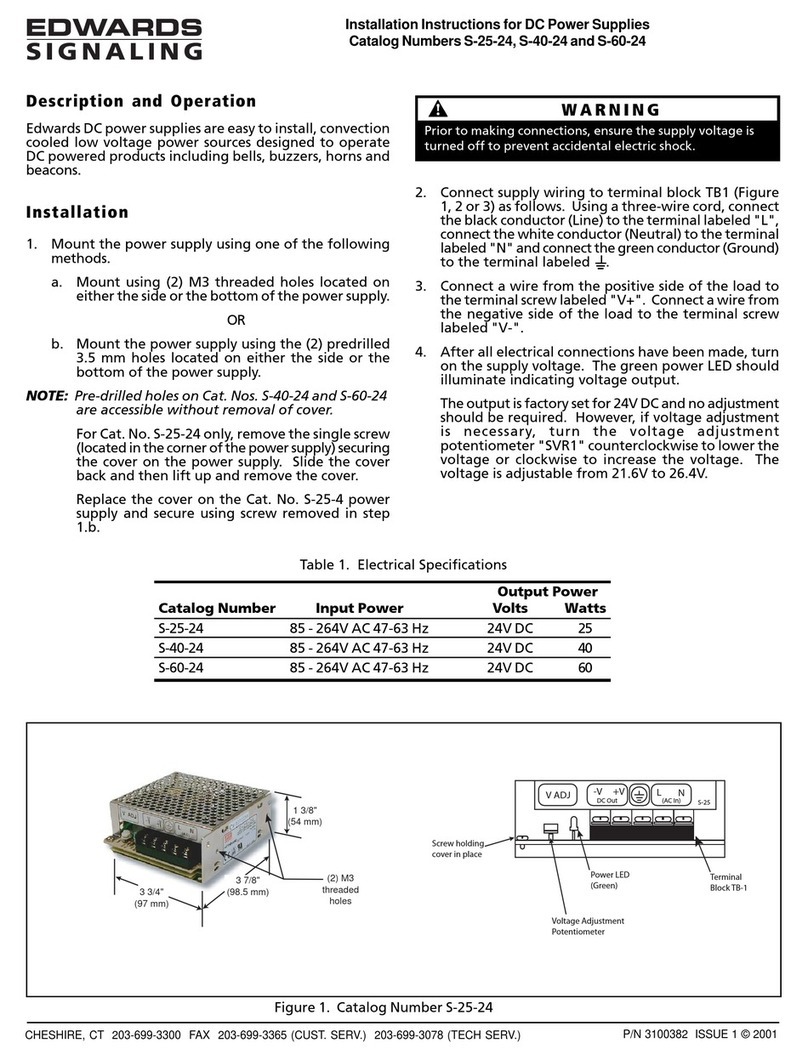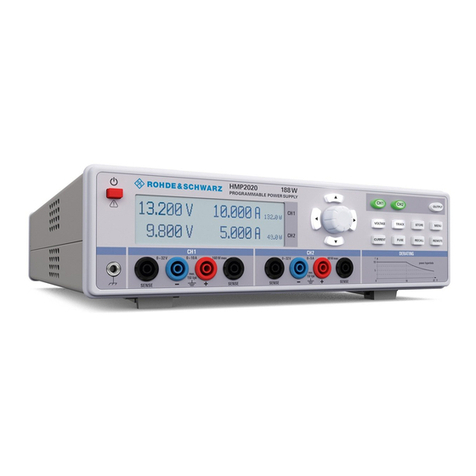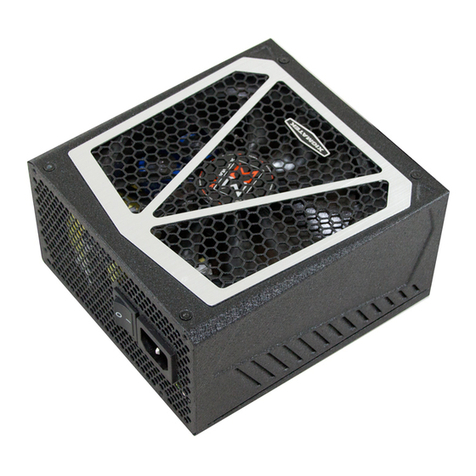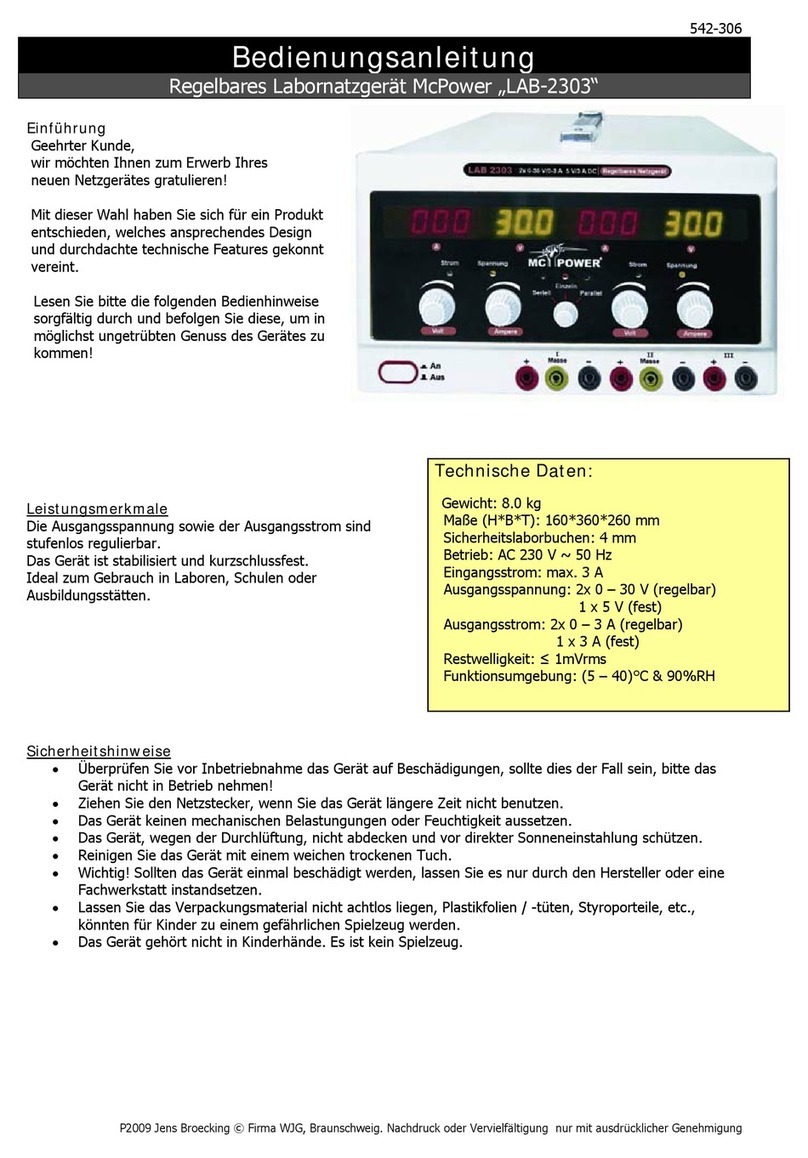Sensata Dimensions ADI-24X25 User manual

Manufacturer of Dimensions™ Inverters
4467 White Bear Parkway
St. Paul, MN 55110
Phone: 651-653-7000 Fax: 651-653-7600
E-mail: inverterinfo@sensata.com
Web: www.dimensions.sensata.com
ISO 9001:2000 Registered Company
DC to AC Standby Power System
Owners Manual for Models:
ADI-24X25
ADI-24X36
Including Options:
A:Emergency Vehicles
B3:3-Step Battery Charger
T:Transfer Switch Relay
U:Utility Vehicles
Form: 122066C
December 2012

2 Form 122066
Table of Contents:
Section Description Page
1 Safety Instructions ..…………………………………………………..… 3
1.1 Warning and Danger Symbols ……..……..…………….…….….. 3
1.2 Standby Power System Precautions ……………………….……… 3
1.3 Battery Precautions …………………….……..………………...…… 3
2 Specifications ……..……………………..…...……………………..…… 4
3 Technical description …..……………………………………………..… 5
3.1 Standby Power Systems …….……….…………………...……....… 5
3.1.1 Inverter Power Mode …………………………………….…. 5
3.1.2 External Power Mode ….……………………………………. 5
3.2 Available Options …………………………………………………….…. 6
3.2.1 Emergency Vehicles – “A” Option .…………………..…. 6
3.2.2 Battery Charger – “B3” Option ……….…………………. 6
3.2.3 Transfer Switch – “T” Option ……………………..……… 6
3.2.4 Utility Vehicles – “U” Option ……………………………… 6
4 SPS Physical Description ..……….……………………………………. 7
4.1 SPS Module ………….…………………..……………….………………. 7
5 Installation ..………………………….…………………………………… 9
5.1 Tools Needed for Installation ..…………………………….………. 9
5.2 System Components ..………………………………….……………... 9
5.3 Mounting the SPS ….…………………………………………………… 9
5.3.1 Chassis Bonding Lug .……………………………………..… 9
5.3.2 Temperature Compensated Sense Wire ……………... 9
6 SPS Wiring …………..……….……………………………………………. 10
6.1 DC Wiring …………………………………………………………….……. 10
6.1.1 Inverter Cable .…………………….………………………….. 10
6.1.2 Charge Cable ..……………………….……..……………..…. 10
6.1.3 Connecting the DC Wires ………..…………………..……. 11
6.1.4 Remote “On/Off” Switch …………………………………… 11
6.1.5 Deep Cycle Batteries .…………………………………..…… 12
6.2 AC Wiring …………………………………………….…………….…..…. 12
6.2.1 AC Output …..…………………………….……………………. 12
6.2.2 AC Input ……..…………………………….……..……………. 12
6.3 DC Wiring Diagram ..…………………………………………………… 13
6.4 AC Wiring Diagram ….………………………….……………………… 14
7 Operation and Troubleshooting ..………………………………....…. 15
7.1 Operation …..……………………………………………………………… 15
7.1.1 Setting the Battery Size and Type ..….…………….….. 15
7.1.2 Turning the SPS On ………….…………..……………..….. 15
7.2 Troubleshooting ……………..………………..………………..….….. 16
8 Warranty ………………………………………..…………………….…… 17

3 Form 122066
Safety Instructions
Important: Read this manual before installation, it contains important safety,
installation, and operating instructions. Save this manual and keep it in a safe place.
1.1 Warning and Danger Symbols:
To reduce the risk of electrical shock and to ensure the safe operation of your
Dimensions power inverter, the following symbols are used throughout the manual.
ATTENTION:
Important operating instructions.
Follow them closely.
DANGER:
Risk of personal harm and/or
electrocution exists in this area.
Use extreme caution.
1.2 Standby Power System Precautions:
•Standby Power Systems produce hazardous voltages. To avoid risk of harm or fire,
the unit must be properly installed.
•There are no user serviceable parts inside, do not remove the cover.
•The Standby Power Systems should not be mounted in a location that may be
exposed to rain or spray.
•The Standby Power Systems should not be installed in a zero clearance enclosure.
•Damage to the Standby Power Systems will occur if correct polarity is not observed
when installing the DC input cables.
•Damage to the Standby Power Systems will occur if an external AC power source is
applied to the inverter’s AC hardwire output.
•The Standby Power Systems contains a circuit breaker and capacitor that may
produce a spark. Do not mount in a confined battery or gas compartment.
•Be sure the Standby Power Systems is turned OFF during installation.
1.3 Battery Precautions:
•Working in the vicinity of lead-acid batteries is dangerous. There is a risk of acid
exposure.
•Batteries generate explosive gases during operation.
•There is risk of high current discharge from shorting a battery that can cause fire
and explosion. Use insulated tools during installation.
•Remove all rings, watches, jewelry or other conductive items before working near
the batteries.
•Inspect the batteries once a year for cracks, leaks or swelling.
•Dispose of the batteries according to local regulations. Do not incinerate batteries;
risk of explosion exists.

4 Form 122066
Specifications
Millennium Series Standby Power Systems
24X25
24X36
MODEL NUMBER 24X25U 24X36U
Output Power (Watts Cont.) 2,500 3,600
Output Current (Amps AC) Up to 21 Up to 30
Peak Output (Amps AC) 80 108
Output Rating: (hp) ¾ 1½
Input Current (Amps DC) Up to 125 Up to 180
Weight (lbs.) 49 58
Dimensions – inches (LxWxH) 15¾ x 11½ x 7¾
BATTERY CHARGER “B3”
(Optional) 3 step charger with automatic conditioning; Temperature compensated
output voltage; selectable between wet and sealed lead acid batteries;
selectable between small and large battery banks.
Output Current (Amps DC) 65 70
Input Current (Amps AC) Up to 25 Up to 26
TRANSFER RELAY “T”
(Optional) Fail-safe shore power Transfer Relay
Current Rating (Amps AC) 30
Transfer Time (milliseconds) 16 typical
Output Voltage (VAC) 120 RMS ±5%
Output Frequency: 60 Hz ± 0.05%
Output Waveform: Quasi-sine wave, with waveform stabilizer
Input Voltage: (VDC) 22 to 28
Operating Temperature: -20° to 40° C (0° to 104° F)
Efficiency: Up to 93%
Other Design Features:
•Thermally-controlled cooling fan
•GFCI outlet protection
•Enclosed AC and DC cable connections with strain
relief
•Remote ON/OFF switch hookup
•LED for Inverter Power, Low Input Voltage, High
Temperature, & Overload
•Battery voltage indicator with push-to-test, “U” option.
•Optional Battery Charger “B3” and Transfer Relay “T”
Unit Protection:
•Automatic electronic short
circuit/overload protection
•Automatic high temperature
shutdown
•Output circuit breakers
Battery Protection:
Automatic low battery shutdown at 21
VDC (with in-rush delay)
•Usage: Any 120 VAC, 60 Hz single-phase products within the standby power system’s rating that does
not require a pure sine waveform.
•Warranty: Full year parts and factory labor (with Advance Replacement Program).
Environmentally Friendly,
Quiet, Reliable, AC Power

5 Form 122066
Technical Description
3.1 Standby Power System:
A Standby Power System is a DC to AC power inverter with an optional battery charger
(“B3” option) and an automatic fast transfer switch (“T” option).
Note: In this manual, we will use the acronym SPS when referring to a Standby Power
System.
The main “On/Off” switch controls the SPS and the LED lights built on the front of the
SPS provides system status. The SPS can also be controlled by a customer supplied
remote “On/Off” switch connected to the violet wire labeled “remote switch hook-up”
located in the field-wiring compartment.
The system has two operational modes when a transfer switch “T” option is included:
Inverter mode and external power mode.
3.1.1 Inverter Power Mode: The SPS converts DC power from batteries to usable
120 VAC, 60 Hz power. The direct current (DC) that enters the SPS is filtered by a large
input capacitor and switched “On” and “Off” by the Metal Oxide Silicon Field Effect
Transistors (MOSFET) at a rate of 60 cycles per second, and directed into the
transformer which steps the voltage up to 120 volts. The unit has a Digital System
Processor (DSP) to control the output voltage and frequency as the DC input voltage
and/or output load varies. The signal output waveform shape is not sinusoidal; it has a
total harmonic distortion of 31% and a maximum single harmonic distortion of 25%.
3.1.2 External Power Mode – “T” option only: 120 VAC, 60 Hz external power
can be applied directly to the SPS by hardwire connections to the AC input wire leads
provided in the field-wiring compartment (available with the “T” option only). When
external power is present, the internal transfer switch cannot be defeated; it
automatically turns the DC to AC inverter OFF and activates the three-step battery
charger if the “B3” option is included. At this time the loads attached to the SPS output
will operate directly from the external power line even if the SPS was turned OFF
manually. The internal transfer relay automatically switches the SPS back to “inverter
power” mode in the absence of external power whenever the SPS was previously set to
ON.

6 Form 122066
3.2 Available Options
3.2.1 Emergency Vehicles – “A” Option: The SPS has only one AC output
circuit with a 20A output breaker. If the “A” option is included the 120VAC 60Hz AC
outlets and the set of hardwire leads are both GFCI protected.
3.2.2 Battery Charger – “B3” Option: The three-step battery charger feature
requires the transfer switch “T” option to operate. External power 120 VAC, 60 Hz is
applied as explained in section 3.1.2 The internal transfer switch automatically turns the
DC to AC inverter OFF and turns the three-step built-in battery charger ON. The battery
charger cannot be defeated at this time and will engage even if the inverter has been
set OFF manually.
The 3-step charging process goes through the following stages: The bulk stage, here
the electrical current is returned to the batteries until a factory set voltage limit is
reached. The acceptance stage is then engaged immediately; the battery voltage is kept
constant while decreasing the charging current gradually up to the transition point or
when it reaches the pre-set timer limit. In the floating stage the batteries are recharged
at a very low current rate to prevent them from self-discharging. Finally the condition
stage is engaged every 20th complete battery charging cycles to ensure full restoration
of active materials in all the plates of the battery cells.
The SPS has an automatic power sharing feature that automatically decrease the battery
charger output so that the total AC input of the SPS for both the AC loads and the
battery charger does not exceed the main 30 amps input circuit breaker. If the loads
exceed 30 amps the charger will be at zero amp draw and the input circuit breaker will
trip. The battery charger draw will automatically increase when the external loads are
reduced if the batteries will accept more current.
3.2.3 Transfer Switch – “T” Option: The transfer switch automatically switches
between “Inverter mode” and “External power mode” depending of the external power
line availability. External power 120 VAC, 60 Hz can be applied directly to the SPS AC
input as explained in section 3.1.2.
3.2.4 Utility Vehicles – “U” Option: SPS having the “U” option where designed
for heavy-duty use on utility vehicle applications. The “U” option provides two AC output
circuits; one circuit is GFCI protected and has one 20A branch breaker. The second
circuit (lead hardwires) is a non-GFCI protected and has a 30A output breaker. All SPS
having the “U” option come with a set of two heat-sinks located at the back of the
chassis for heat dissipation purposes. A push to test LED battery voltage meter is also
included with the “U” option.

7 Form 122066
SPS Physical Description
4.1 SPS Module
FIGURE 1: Chassis physical description
Item # Description Function
1 “On/Off” Switch. Turns the inverter ON/OFF
2 Branch Breaker – 20A Trips to protect the inverter from GFCI outlet short
circuit or overload. Not available with “A” option.
3 Output Breaker – 15A, 20A, 30A Trips to protect the inverter from hardwire AC output
short circuit or overload.
4 GFCI Outlets Two outlets, output power120 VAC 60 Hz.
5 Field Wiring Compartment Cover Remove the faceplate to access the AC Input/Output
lead wires and DC field-wiring compartment.
6 Comp. Temp. Sensor Connector Connects to the remote temperature sense probe.
Available with the “B3” option only.
7 Bonding Lug Connects to the ground system.
8 DC input entry opening Allows the DC cables to reach the DC input terminal
connector.
9 Battery Capacity Selector Switch Sets the correct battery type and the capacity of the
battery bank for proper charging. Available with “B3”
option only.
10 LED Status Control Panel Provides inverter status – See next page
1
2
3
4
5
6
7
8
9
10

8 Form 122066
FIGURE 2: LED Front Control Panel
(a) External power – “T” option: The green LED indicates that there is external
120 VAC, 60 Hz connected to the unit.
(b) Inverter power: The green LED indicates that the SPS is operating from
batteries in “inverter mode”.
(c) Low battery: The red LED indicates that the SPS is in a low battery voltage
condition.
(d) Overload: The red LED indicates that the SPS is in an overload condition.
(e) High temp: The red LED indicates that the SPS has a high internal
temperature.
(f) Bulk mode – “B3” option: The green LED indicates that the battery charger
is in the bulk mode.
(g) Accept mode – “B3” option: The green LED indicates that the battery
charger is in the acceptance mode.
(h) Float mode - “B3” option: The green LED indicates that the battery charger
is in the float mode.
(i) Condition mode - “B3” option: The green LED indicates that the battery
charger is in the condition mode. Available with the “B3” option only.
(j) Check battery - “B3” option: The yellow LED indicates a possible fault in the
battery bank or DC cables.
(k) Push to test – “U” option: Pressing this button enables the appropriate
battery voltage LEDs as shown below.
(l) 28 – 30 VDC (Battery voltage): Yellow LED.
(m) 26 – 28 VDC (Battery voltage): Yellow LED.
(n) 24 – 26 VDC (Battery voltage): Green LED.
(o) 22 – 24 VDC (Battery voltage): Green LED.
(p) 20 – 22 VDC (Battery voltage): Green LED.
c
b
e
a
d
f
g
h
i
k
l
j
m
n
o
p
28-30 VDC
26-28 VDC
24-26 VDC
22-24 VDC
20-22 VDC

9 Form 122066
Installation
5.1 Tools for Installation:
Tools required for installation: 3/8” Allen Wrench and socket wrench, connectors (butt
type and insulated), drill, Crimpers (for insulated and non-insulated connectors), volt
meter with probes, electrical tape, #2 Phillips screwdriver, wire cutters, wire strippers,
cable ties, tape measure.
5.2 System Components:
Picture Model and Description Qty.
12X16, 12X20, 12X25, 12X30, 12X36 with options A, B3, T & U
1
Temp. Comp. Cable 611440-XX (“B3” option only)
XX: Length of the cable in feet
1
5.3 Mounting the SPS:
The SPS mounting location should provide adequate ventilation and clearance
to maintain room temperature during operation. At least 1/2 inch of clearance
is required on all sides.
•Locate a suitable, secure vertical or
horizontal mounting surface as close to the
batteries as possible without being in the
same airtight compartment.
•If mounting the SPS on a vertical surface, it
is recommended that the front control panel
be pointing down whenever possible.
•Locate the mounting holes on the chassis
flanges and fasten them using ¼ inch
diameter screws to secure the inverter. See
figure 3.
5.3.1 Chassis Bonding Lug: Connect the
bonding lug located at the right side of the SPS
chassis to the earth grounding system using an
8-gauge copper wire.
5.3.2 Temperature Compensated Sense Wire: If the SPS has the battery
charger “B3” option, connect the two-conductor wire to the negative post of the battery
bank. Failure to connect the remote temperature sense probe correctly will result in high
output voltage that will cause severe damage and exploding batteries and fire.
Figure 3: Inverter footprints
•All dimensions are in inches
•Heatsinks available with the
“
U
”
opt
i
o
n
o
nl
y
.
Heatsinks

10 Form 122066
SPS Wiring:
6.1 DC Wiring:
1It is recommended in all cases to use stranded copper wires.
2Use SGX cross-linked polyurethane insulation type that complies with the high
temperature insulation requirements (125°C.) of SAE J-1127 and vehicle
manufacturer requirements.
3Wire gauge recommendations are minimum. For lower temperature rated,
applications inside engine spaces or large motor loads and other applications with
high surge currents use wire gauge 1 to 2 sizes larger than shown on table I.
4Keep the wire runs between battery and SPS as short as possible.
5Use Bussmann fuse type ANN-XXX and fuseblock # 3576 where XXX is the size of
the fuse.
6.1.1 Inverter Cable: This is the cable that runs from the SPS module to the
batteries. Estimate the “inverter cable” length and locate your SPS model on table I,
cross-reference the wire gauge and fuse size.
Table I: Wire and Fusing Guide for 12VDC systems at 5% Voltage Drop at Full Output
6.1.2 Charge Cable: This is the cable that runs from the batteries to vehicle
alternator or OEM engine battery. Use 2-gauge cables and 250A fuse for small OEM
alternators and 1/0-gauge and 350A for heavy-duty alternators.
Figure 4: Inverter and charge cable assembly description
Inverter
Model Full Load
(Amps DC) Inverter to battery estimated cable length in feet
1’ – 10’ 11’ – 15’ 16’ – 20’
24X25 125 2-gauge, 250A fuse 2-gauge, 250A fuse 1/0-gauge, 350A fuse
24X36 180 1/0-gauge, 350A fuse 2/0-gauge, 400A fuse 3/0-gauge, 500A fuse
To inverter
DC input
To
Batteries Fuse-holde
r
Black wire (-)
A
20 feet maximum
B
18” max.
Red wire (+)
A
B
Fuse B terminal: 5/16” RingA terminal:
3/8” Ring

11 Form 122066
6.1.3 Connecting the DC wires:
Damage to the SPS not covered under warranty will occur if correct polarity is
not observed when installing the DC input cables.
•Open the SPS field-wiring compartment to access the DC input connectors.
•Remove the fuse in the red cable for cable installation.
•Connect the red wire to the input terminal labeled POS (+) and the black wire to the
input terminal labeled NEG (-).
•Connect the other red end to the POS (+) battery post.
•Make sure that the black wire (return wire) is connected directly to the battery NEG
(-) post and does not use the chassis to carry the return current.
•Install the in-line fuse in the fuseholder that is within 18” from the positive post of
the battery bank. To determine the fuse size, see the procedure in section 6.1.1.
6.1.4 Remote “On/Off” Switch: An optional customer supplied “On/Off” switch
may be connected to the SPS. The remote switch will operate only if the main “On/Off”
switch on the face of the SPS is turned ON.
•Open the SPS field-wiring compartment to access the DC input connector.
•Locate the violet wire labeled “Remote Switch Hook-up” and remove it from the
positive battery connector.
•Connect the violet wire to the load side of the “On/Off” remote switch.
•Using an 18-gauge wire, connect a fused (5 amp recommended) +24VDC battery
voltage to the line side of the switch.
•The fuse should be mounted within 18 inches of the battery’s positive post.
•All material used for the remote switch should be UL listed and installed per code.
6.1.5 Deep Cycle Batteries:
Do not use vehicle-starting batteries; deep discharge cycles typical with SPS
applications can shorten the life of this type of batteries.
•Install at least one auxiliary deep cycle battery to feed the SPS directly. Depending
on the application running time more batteries could be added if necessary. The
vehicle alternator will recharge the batteries.
•It is recommended to mount the battery bank close to the SPS. The maximum
recommended distance between the SPS and the battery bank is 20 feet.
•The battery compartment must be vapor-tight to the interior of the vehicle and
vented directly to the exterior.
•Install several vent-plugs within one inch of the top of the battery compartment to
allow for ventilation. Install a ventilation assembly as needed.
•Allow space around the battery and especially above the battery for inspection, and
maintenance purposes.
•The battery should not be able to move more than 1 inch in any direction.

12 Form 122066
6.2 AC Wiring:
Remove the SPS field-wiring compartment cover plate to access the 120VAC, 60Hz input
and output hardwire leads and follow the color code connections: Hot - Black wire,
Neutral - White wire, Ground - Green wire.
6.2.1 AC Output: The 120 VAC, 60 Hz current produced by the SPS is provided at
the GFCI receptacle outlets located on front of the SPS (“A” and “U” options only). The
output is also presented behind the wiring compartment panel for direct hardwire leads.
•If the option “A” is included, the hardwire leads are GFCI protected; therefore there
is no need to install remote GFCI outlets.
•If the option “U” is included, the hardwire leads are not GFCI protected and must
require the installation of remote GFCI outlets. The GFCI outlets model
recommended is Hubbell # GFR 5352XX (20A) or GFR 5252XX (15A).
•If the “A” and “U” options are included together, the hardwire leads are GFCI
protected; therefore there is no need to install remote GFCI outlets.
Do not connect another source of AC power directly to the output of the SPS.
This will result in damage to the SPS that is not covered under warranty.
6.2.2 AC Input: If the transfer switch “T” option is included, the AC input hardwire
leads can be connected to an external power line 120VAC, 60Hz outlet. The cable clamp
strain relief should be used to secure the field wires. The input circuit should have a
maximum 30 amps circuit protection from the distribution panel. If the input cable to the
unit is 14-gauge, then a 15 amps circuit protection is required.

13 Form 122066
6.3 DC Wiring Diagram
- +
Aux.
24 Volts
Battery
Fuse
Charge Cable
Black (-)
Remote
On/Off Switch
Vehicle Alternator
OEM
24 Volts
Batter
y
Fuse
Fuse
AC Output AC Input
“T” Option
Under the hood
Fuse
Remote Temp. Sense
“B3” Option
Red (+)
Black (-)
Charge Cable
Red (+)
•
Connect the charging cables directly to
the vehicle alternator whenever possible
or to the OEM starting engine battery.
•
AC input cable set is available with
options “T” only.
•
Remote Temperature Sense available
with option “B3” only.
•
Remote “On/Off” switch and fuse is
customer supplied.
•
If the remote “On/Off” is not used no
connection is necessary.
2-pin
Connector
“B3” Option
Violet wire

14 Form 122066
Figure 5: DC wiring diagram
6.4 AC Wiring Diagram
Figure 7: AC wiring diagram
30
Output
Breaker Branch
Breaker
AC Output AC Input
30A
20A
Black wire – Hot
White wire – Neutral
Green wire - Ground
GFCI Outlets
Available with the
“U” or “A” o
p
tions onl
y
Black White Green
Wire Wire Wire
H
o
t Neutral Gr
o
und
•“U” option: Install GFCI outlets
Hubbell # GFR5352XX (20A) or
Hubbell # GFR5252XX (15A)
•“A” or “A” and “U” options together:
Do not need to install GFCI outlets.
20
120VAC 60Hz Output
Available with the “U” option only
AC Input
Fuse (maximum)
“A” option: 15A, 20A
Remote GFCI outlet
Fuse

15 Form 122066
Operation and Troubleshooting
7.1 Operation
The battery voltage must be higher than 18 volts for the SPS to operate.
7.1.1 Setting the Battery Size and Type: The battery selector switch located at
the right side of the chassis must be set according to the type and size of the battery
bank the SPS is connected to as shown in table II below.
TABLE II: BATTERY SELECTOR SWITCH POSITION
BATTERY BANK SIZE
(Amp-Hour) DEEP CYCLE BATTERY TYPE
SEALED LEAD ACID WET LEAD ACID
More than 400 A C
Less than 400 B D
TABLE III: BATTERY CHARGER VOLTAGES
BATTERY
TEMPERATURE WET CELL BATTERIES SEALED BATERIES
ACCEPT
(Volts) FLOAT
(Volts) CONDITIONING
(Volts) ACCEPT
(Volts) FLOAT
(Volts) CONDITIONING
(Volts)
°F °C
78 25 28.8 26.4 29.4 to 30 max. 28.4 26.4 28.8 to 30 max.
TABLE IV: BATTERY CHARGER TIME PERIODS
BATTERY BANK SIZE
(Amp-Hour)
WET CELL TYPE BATTERIES SEALED TYPE BATTERIES
BULK
(max.) ACCEPT
(max.) CONDITIONING
(max.) BULK
(max.) ACCEPT
(max.) CONDITIONING
(max.)
Less than 400 6-hrs. 2-hrs. 4-hrs. 6-hrs. 2-hrs. 3-hrs.
Greater than 400 8-hrs. 3-hrs. 6-hrs. 8-hrs. 3-hrs. 4-hrs.
If the bulk mode times-out the charging process will go to the float mode
immediately bypassing the acceptance mode.
7.1.2 Turning the SPS “ON”: To turn the SPS ON, set the main switch to the “On”
position. The green LED “Inverter Power” will come on. If the “T” option is included, the
green LED “Inverter Power” will come only if no external power 120VAC 60 Hz is applied
to SPS AC input, otherwise the green LED “External Power” LED will come on. If the
remote switch is used, the inverter is turned ON or OFF by the remote switch.
Turn the SPS OFF if not in use. There is an approximated 1 to 2 amps DC
draw from the batteries at idle or no load.

16 Form 122066
7.2 Troubleshooting
Call or e-mail Customer Service Department for free consultation during business hours
(central time zone) at: 1-800-553-6418 or 1-651-653-7000; fax: 1-651-653-7600;
e-mail: [email protected]
•A TRUE RMS voltmeter is required for accurate AC output voltage readings on a
quasi-sine SPS. A voltmeter that uses averaging circuitry will give a false reading.
•Unplug all loads and connect a 100-watt light bulb to the inverter output. Observe
the LEDs light coming on at the control panel then check the troubleshooting table.
Table V
PROBLEM POSSIBLE CAUSES OR SOLUTIONS
No LEDs: No power output. The SPS is not
connected to the batteries; the battery
voltage is below 18 volts DC or fault in the
remote On/Off circuit.
Check the in-line fuses for continuity. Make sure the DC
wires are clean and tight. Check the DC voltage at the SPS
DC input. Check or bypass the remote On/Off circuit.
Low battery: Red LED indicator light.
Indicates that the SPS has shut off due to a
low battery voltage condition.
Fault in the battery wiring, battery capacity and voltage or
the in-line fuse. This message will automatically clear or the
SPS will shut off.
Overload: Red LED indicator light.
Indicates that the SPS has shut off due to
an overload condition.
The SPS output wiring is shorting or loads exceed the
inverter rating. This message will automatically clear or the
SPS will shut off. Remove the short circuit or excessive load
from the output, and then switch the SPS off then on.
High Temp: Red LED indicator light.
Indicates that the SPS has shut off due to
high internal temperature. The unit will
automatically turn back on when it has
cooled to 40°C (104°F)
Verify that the SPS is in a vented compartment and that the
fan is not blocked. High ambient temperatures combined
with poor ventilation may also contribute to the shut down.
Check battery - “B3” Option: Yellow
LED indicator light. Indicates that the
charger is operating in a low DC output
voltage condition. The battery voltage must
be higher than 18 volts for the charger to
operate.
Shorted or defective battery. Make sure that the DC cable
connections are tight and clean and not shorted, and that
the proper wire gauge is used.
Indicates that the charger is operating in a
high DC output voltage condition.
There is another source of battery charging or there is a
defective battery charger. Disconnect and reconnect the
external AC power to restart the battery charger.
Indicates that the SPS has shut off due to
high battery voltage. The unit will
automatically turn back on when the
condition is removed.
Check battery wiring or remove other source of battery
charging, such as the vehicle alternator.

17 Form 122066
Warranty
SHIPPING TERMS: F.O.B. St. Paul Minnesota. Freight prepaid and billed, subject to prior credit approval.
MINIMUM ORDER: $50.00 Net Price
LOSS OR DAMAGE: Loss or damage in transit are the responsibility of the carrier. Any claim should be filed with the
delivering transport company. Invoice, Bill of Lading and Delivery receipt with damage noted therein must accompany any
claims for freight damage. Claims for shortage and lost shipments must be made in writing to Sensata Technologies,
Power Controls White Bear, St. Paul, MN within 10 days of date of shipment. Claims not reported within this time frame
will not be honored.
PRICES: Prices are subject to change without notice. All orders are subject to acceptance at the factory. We reserve the
right to invoice prices in effect at time of shipment.
TERMS: Net 30 days with approved credit, credit card or C.O.D.
RETURN GOODS POLICY:
• No returned materials will be accepted without an accompanying Returned Materials Authorization Number (RMA) from
the factory.
• Credit will be issued for returned goods to the original purchaser within 60 days of purchase, provided the inverter is
returned to Sensata unused and not mounted. The amount of credit will be issued at Sensata’s discretion based on the
condition of the product.
• Customer must be in good standing with Sensata Technologies.
• Inverters that are discontinued, high-voltage (over 24vdc), special-order or used are excluded and will not be eligible for
credit. Non-inverter items such as cable assemblies, fuses and fuse holders, will not be eligible for credit
• Support components supplied by Sensata vendors will be covered under that manufacturer’s credit return policy.
• Customer pays return freight.
PLEASE SHIP AUTHORIZED RETURNS TO:
Sensata Technologies | Power Controls White Bear | 4467 White Bear Parkway | St. Paul, MN 55110
Return Freight Prepaid
LIMITED WARRANTY:
Sensata Technologies extends the following warranty to the original purchaser of those goods subject to the qualifications
indicated. Sensata warrants to the original purchaser for use that the goods or any component thereof manufactured by
Sensata will be free from defects in workmanship from the date of purchase for the period listed on the product label,
provided such goods are installed, maintained and used in accordance with Sensata and the original manufacturer’s
written instructions. Damages caused by the misuse, undue care or obvious wear through use will not be covered by this
warranty.
Components not manufactured by Sensata, but used within the assembly provided by Sensata, are subject to the
warranty period as specified by the individual manufacturer of said component, provided such goods are installed,
maintained and used in accordance with Sensata and the manufacturer’s written instructions.
Sensata’s sole liability and the Purchaser’s sole remedy for a failure of goods under this limited warranty and for any and
all claims arising out of the purchase and use of the goods, shall be limited to the repair or replacement of the goods that
do not conform to this warranty.
To obtain repair or replacement service under the limited warranty, the purchaser must contact the factory for a Return
Material Authorization (RMA). Once obtained, send the Return Material Authorization Number along with the defective
part or goods to:
Sensata Technologies, Power Controls White Bear, 4467 White Bear Parkway, St. Paul, MN 55110. Return Freight Prepaid.
THERE ARE NO EXPRESS WARRANTIES COVERING THESE GOODS OTHER THAN AS SET FORTH ABOVE. THE IMPLIED
WARRANTIES OF MERCHANTABILITY AND FITNESS FOR A PARTICULAR PURPOSE ARE LIMITED IN DURATION TO ONE
YEAR FROM DATE OF PURCHASE.
SENSATA TECHNOLOGIES ASSUMES NO LIABILITY IN CONNECTION WITH THE INSTALLATION OR USE OF THE
PRODUCT, EXCEPT AS STATED IN THIS LIMITED WARRANTY. SENSATA TECHNOLOGIES WILL IN NO EVENT BE LIABLE
FOR INCIDENTAL OR CONSEQUENTIAL DAMAGES.
WARNING:
LIMITATIONS ON USE: DIMENSIONS®brand products are not intended for use in connection with Life
Support Systems and for Avionic use. Sensata Technologies makes no warranty or representation in connection with their
products for such uses.
This manual suits for next models
1
Table of contents
Other Sensata Power Supply manuals
